Indigenous Whispers Featured in Dade Heritage Trust’s Annual Magazine
The 2025 issue of Preservation Today highlights the innovative project bringing Miami’s Indigenous stories to life through augmented reality.
The Pinecone – potential housing for a hologram installation at Fort Dallas on the Miami River
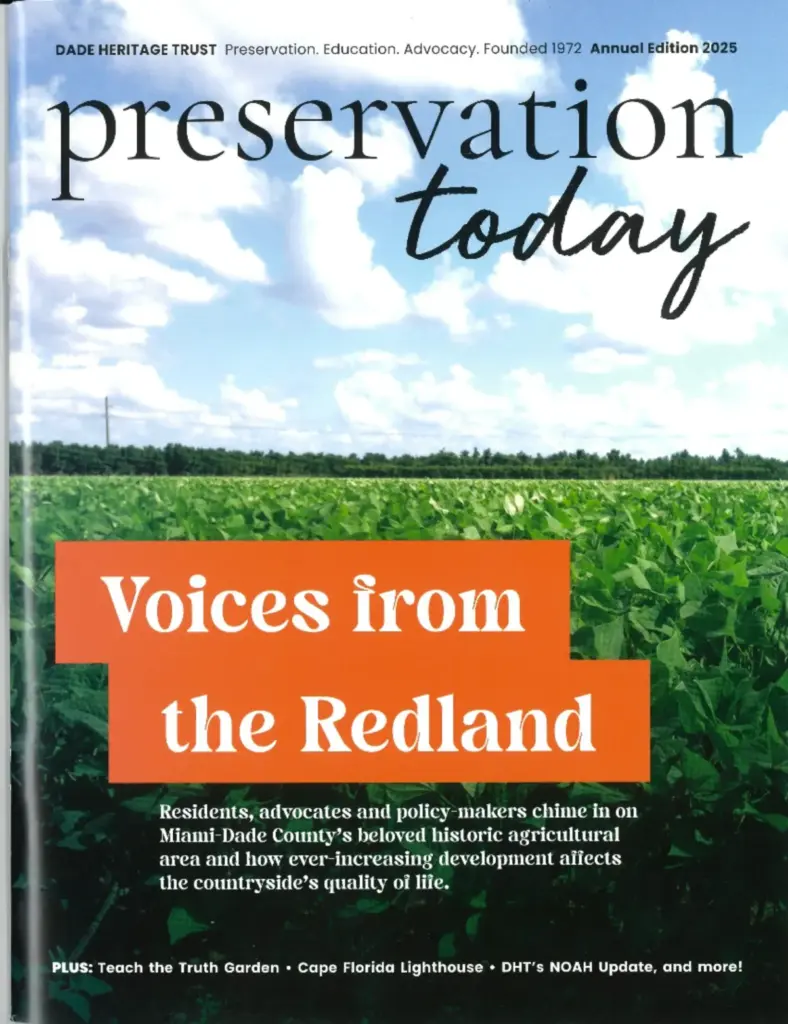
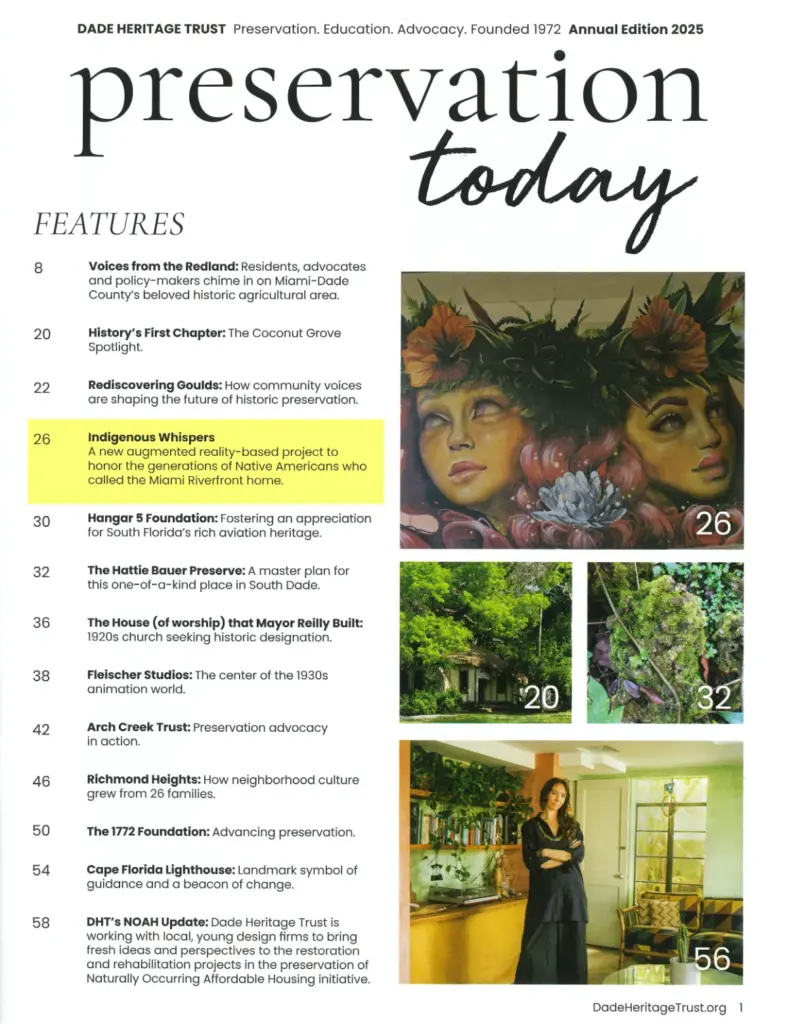
By Jeff Zbar
Khadijah Cypress remembers growing up among the elders of her Miccosukee tribe west of Miami. Her grandparents would share stories of their own upbringing – stories retold by the elders who guided each generation from their community within the Florida Everglades. Young Khadijah learned dressmaking from her grandmother and heard stories of her culture and heritage from her grandfather. “You can be what you want to be,” Khadijah recalled him telling her. “At the end of the day, you’re Miccosukee and you’ll
always come back to that.”
To help those stories live on, “Indigenous Whispers” will create a series of augmented reality (AR) shorts at stops along a Miami River walking path, and potentially a hologram at nearby Ft. Dallas Park. The stories will give voice to generations of Miccosukee.
The idea came to life in a short film screened at a meeting of the City of Miami Historic and Environmental Preservation Board (HEPA) during a discussion of how best to preserve the huge number of Tequesta archaeological relics discovered along the south bank of the Miami River just west of Brickell Bridge. The Miccosukee consider the 7,000-year-old Tequesta site an ancestral burial ground.
“These are stories passed down from grandparent to grandchild in the Indigenous community,” said
Judith Anderson, co-founder of Indigenous Whispers with Christine Michaels. “I would love people to visit
Miami and be moved by these stories.”
The sophisticated blend of technology and storytelling will create an interactive experience to bridge Native American wisdom and timeless
themes like nature, community and resilience and employ technology to underscore Miami’s emergence as a global tech hub.
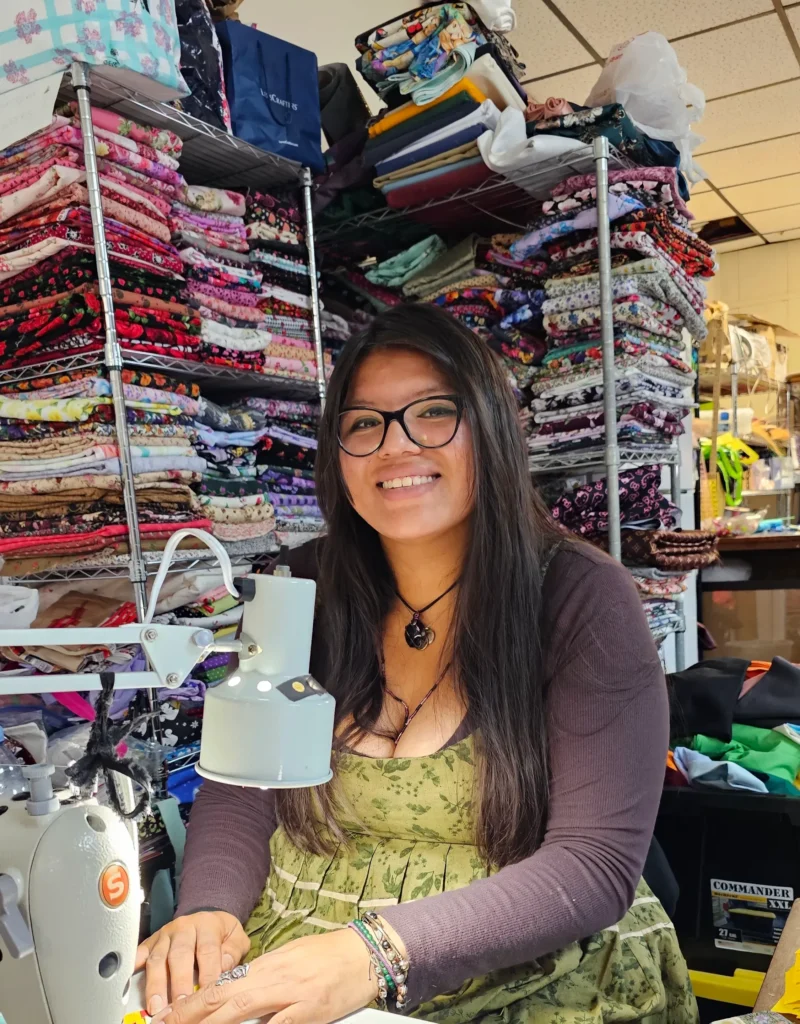
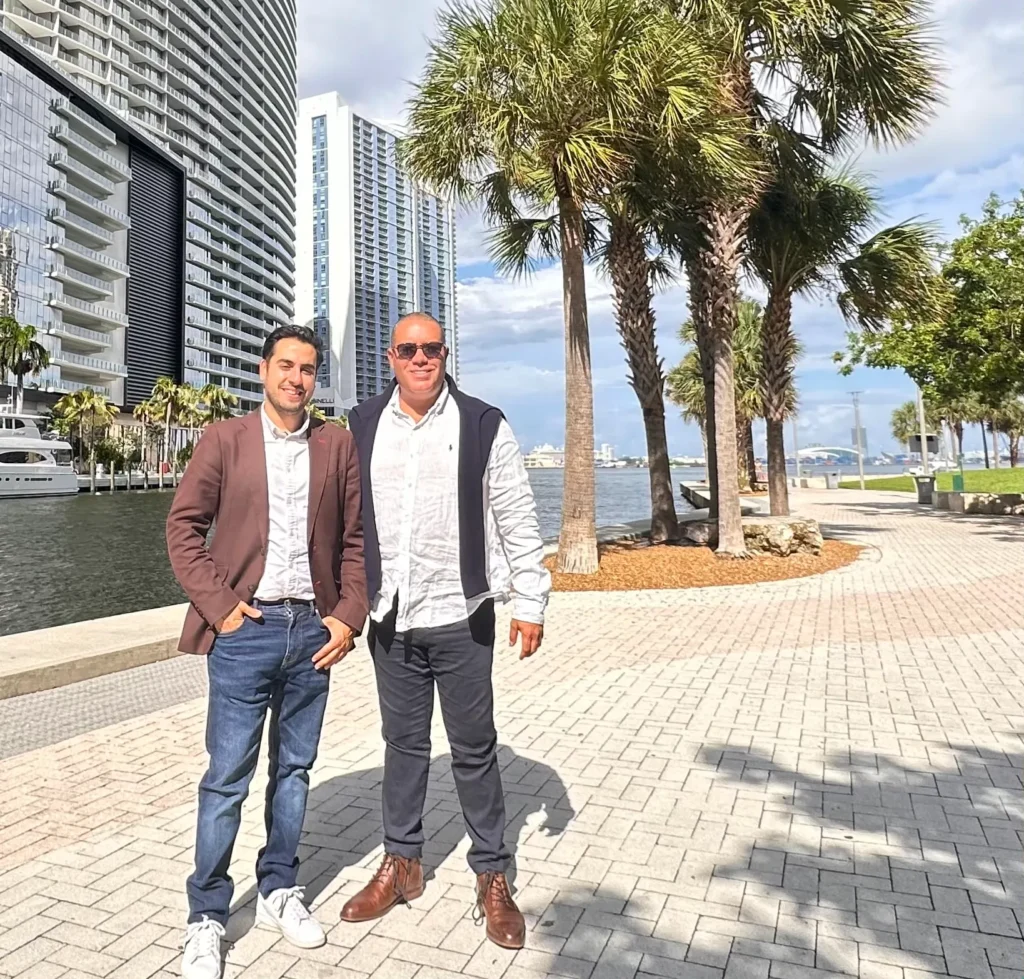
Mario Lopez and Carlos Ohep – partners at Bravent and experts in augmented reality technology
Using their smartphone to scan QR codes, visitors will see a grandmother sharing how to collect and eat vegetation originally native to the banks of the Miami River, or telling a young child how a caterpillar that soon will transform into an Atala butterfly shares lessons of healing.
Augmented reality can bring to life a place’s history and layer in the telling of the change a community has seen, said Mario Lopez, partner and chief innovation officer with technology partner Bravent, which is helping to create the pilot production.
“With AR, you are in that place,” said Lopez, who has produced similar augmented reality projects for the World Cup.
Former head of Miami-Dade’s Historic Preservation Division, Dr. Robert S. Carr, was at the screening of Indigenous Whispers. Impressed with the project, Carr included funding for their pilot in a grant proposal seeking state funds to underwrite the Tequesta Trail, a project he is spearheading. Indigenous Whispers will co-locate with Tequesta Trail markers when appropriate.
“It’s very important to give a sense of Miami and South Florida that transcends the modern urban experience,” said Carr, who explored ancient mounds along the river as a teen, and today is director of the Archaeological and Historical Conservancy, Inc. “We have thousands of years of human history right here in Miami. These efforts help our community to build a sense of place.” Also at the video’s screening were developer representatives who will soon present a plan to HEPB to archive and preserve relics of the past and educate the public on the importance of the findings. “This will be our best opportunity to tell Miami’s story,” said attorney Iris Escarra, who has been involved in 40 such site preservation efforts.
“At the end of the day, you’re Miccosukee and you’ll always come back to that.”
Khadijah Cypress
“Understanding the history of the Miami River helps us understand why we have the Miami we have today,” said Horacio Aguirre, chair of the Miami River Commission, who as a youth in the 1950s explored the river’s banks. The organization has supported pilot planning for Indigenous Whispers project, the greenway project, and many other important historical efforts.
“Throughout the world, all civilizations and social groups start where there’s water,” he said. “If we’re going to understand the Miami of today, we need to reach back as far as we have knowledge. Let’s learn about the history of all of Miami by starting with the history of the river.”
Michaels, a producer of award-winning historical tours from the Art Deco District to Little Havana, sees the Miccosukee stories as a way to retell Miami’s true history.
“There’s this perception that Miami is a concrete jungle,” she said. “Other cities around the world have found a balance between development, respecting our history, and preserving culture. That’s the balance we want to achieve.”
Michaels and Anderson hope Indigenous Whispers will tell traditional stories, not from the voice of historians, archaeologists, or settlers, but through the voice of the indigenous populations themselves, and touch the hearts of Miamians and visitors alike.
Images courtesy of Judith Anderson.
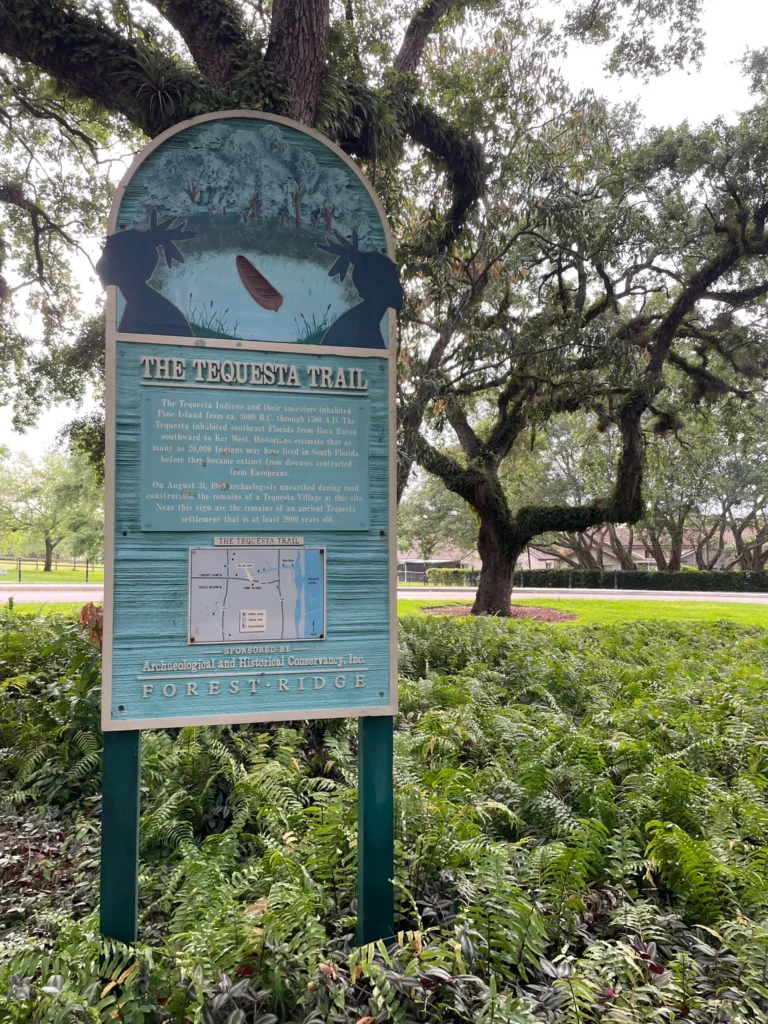
Tequesta Trail Marker courtesy of the
Archaeological and Historical Conservancy
The FOUNDERS

Judith Anderson
Business Coach, Author, & Entrepreneur
- Judith has had a passionate 30-year love affair with the Miami River, captured in her photo blog, Miami River Watch.
- She moved to Miami in 1984 to accept a senior position with Ryder, where she spearheaded the entry into the company’s third-party logistics business—now its dominant segment—long before other companies recognized the opportunity.
- In 1990, she founded Anderson & Rust, focusing on leadership development and team coaching, long before the idea of coaching became established in the corporate world.
- Over 30 years, Judith trained coaches and worked with organizations worldwide, bringing ideas to life with her knack for sensing opportunities.
The Spark for Indigenous Whispers
- Judith was drawn to this project after hearing impassioned pleas from the Indigenous population regarding relics found along the Miami Riverbanks.
- She noticed their voices were not truly being heard. While realistic about how much of the riverfront could be protected, she mused about how their culture could still be honored.
- Inspired, she envisioned leveraging the developing Miami River Walk to achieve this goal.
- After meeting Christine Michaels—whose ability to translate culture into stories impressed her—the idea for Indigenous Whispers was born.

Christine Michaels
Cultural Curator & Heritage Storyteller
- Christine’s profound impact on Miami's cultural landscape began with her acclaimed Little Havana Walking Tours, which earned prestigious recognition in the top 10% of world attractions by TripAdvisor, establishing her as a trusted voice in cultural tourism.
- Her intimate understanding of heritage storytelling evolved into Little Havana Shop, where she innovatively bridges culture and fashion through sustainably crafted hats.
- She believes fabric is a universal language and that every stitch tells a story of tradition.
A Mission to Preserve Tradition
- This deep-rooted commitment to preserving and sharing cultural narratives naturally led Christine to cofound Indigenous Whispers, a mission-driven initiative dedicated to honoring the heritage of Miami's original inhabitants, the Tequesta Indians.
- Through this meaningful progression—from cultural tour guide to fashion curator to Indigenous culture preservationist—Christine continues to weave together the diverse threads of Miami's rich cultural tapestry.
- Her efforts ensure that ancient stories and traditions remain vibrant and relevant for future generations.


